Mark Sisson's Blog, page 127
October 15, 2018
Dear Mark: Omega-6 Deficiency and Saw Palmetto
 For today’s edition of Dear Mark, I’m answering two questions from readers. First, is it possible to become deficient in omega-6 fats as an adult? What would that even look like, and is there anything that might make omega-6 more important?
For today’s edition of Dear Mark, I’m answering two questions from readers. First, is it possible to become deficient in omega-6 fats as an adult? What would that even look like, and is there anything that might make omega-6 more important?
Second is a question related to last week’s feature on prostate health. Is saw palmetto an effective supplement for prostate issues? It depends on the issue.
Let’s go:
I have a question for “Dear Mark”
Here it is:
I am completely and totally primal for 10 years now. Can I become O6 deficient ? Since 90% of my fat intake is saturated or O3.
It’s technically possible to become deficient in omega-6 fatty acids. The early rat studies that discovered the essentiality of Omega-6s found that their complete removal made the subjects consume more food (without gaining weight), drink more water (without peeing more than rats on a normal diet), develop scaly skin, lose fur, urinate blood, go infertile, grow weird tails, and die early. All this despite eating an otherwise nutrient-dense diet with all the fat-soluble vitamins (they even removed the fat from cod liver oil and gave the vitamins), B vitamins, and other nutrients a rat could ever want. The only thing missing was a source of omega-6 fats.
Once they discovered the issue—a lack of omega-6—how’d they fix it?
Coconut oil didn’t work, for obvious reasons. It’s almost pure saturated fat.
Butter worked, but you had to use a lot. The omega-6 fraction of butter is quite low.
Cod liver oil worked, but it didn’t fully cure the deficiency disease.
Lard worked well, as did corn oil, liver, flax oil, and olive oil. All of those fat sources fully resolved the issue and eliminated the symptoms. They were all good to decent sources of omega-6 fatty acids.
They also tried pure linoleic acid (the shorter-chained omega-6 PUFA found in nuts and seeds and the animals that eat them) and arachidonic acid (the long-chain omega-6 PUFA found in animal foods). Both worked, but AA worked best.
Throughout all these trials, exactly how much omega-6 fat did the rats require in their diets to cure deficiency symptoms?
When they used lard to cure it, the rats got 0.4% of calories from omega-6 PUFA. If the numbers hold true for humans, and you’re eating 2500 calories a day, that’s just 10 calories of omega-6, or about a gram and a half of pure arachidonic acid to avoid deficiency.
When they used liver to cure it, the rats got 0.1% of calories from omega-6 PUFA. If the numbers hold true for humans, and you’re eating 2500 calories a day, that’s just 2.5 calories of omega-6, or about a third of a gram of arachidonic acid to avoid deficiency.
The truth is that omega-6 deficiency is extremely hard to produce, even when you’re trying your hardest. Way back in the 1930s, the early omega-6 researchers tried to induce deficiency in an adult by giving him a 2 grams fat/day diet for months. Nearly all fat was removed, particularly the omega-6 fats, and the rest of the diet was fat-free milk, fat-free cottage cheese, orange juice, potato starch, sugar, and a vitamin/mineral supplement. Maybe not the ideal Primal diet, but better than some.
He ended up improving his health, not hurting it. There was no sign of deficiency.
Omega-6 fats are everywhere in the food environment, even if you’re actively avoiding concentrated sources of them. No one is developing a deficiency these days. However, certain conditions might increase the tolerable or beneficial upper limits of omega-6 intake.
If you’re strength training with the intent to gain lean mass, a little extra arachidonic acid can improve your results. The dose used was 1.5 grams per day. Average intake through food runs about 250-500 mg, though Primal eaters heavy on the animal foods are probably eating more.
If you’re recovering from injury or healing a wound, a little extra arachidonic acid can speed it up. AA is an important co-factor in the inflammatory response necessary for tissue healing.
Well done, Mark. My doc just prescribed saw palmetto to reduce multiple nighttime visits to the bathroom, though the research I’m looking at says there’s no clinical evidence to support saw palmetto for prostate problems. Your take?
It depends on the problem.
Large observational trials have found no connection between saw palmetto supplementation and prostate cancer risk. It neither helps nor harms.
Saw palmetto does seem to help benign prostatic hyperplasia, a non-cancerous growth of the prostate. This won’t cause serious health issues directly, but it can impede the flow of urine and lead to multiple nighttime bathroom visits. Saw palmetto is quite effective at reducing nighttime urination. If that’s what your doc is trying to help, I’d say give it a shot.
You might ask about combining saw palmetto with astaxanthin. It’s been shown to reduce the conversion of testosterone into estradiol that can sometimes result from plain old saw palmetto supplementation.
That’s it for today, folks. Take care and be well. Chime in down below if you have any questions or comments.

References:
Mitchell CJ, D’souza RF, Figueiredo VC, et al. Effect of dietary arachidonic acid supplementation on acute muscle adaptive responses to resistance exercise in trained men: a randomized controlled trial. J Appl Physiol. 2018;124(4):1080-1091.
Oh SY, Lee SJ, Jung YH, Lee HJ, Han HJ. Arachidonic acid promotes skin wound healing through induction of human MSC migration by MT3-MMP-mediated fibronectin degradation. Cell Death Dis. 2015;6:e1750.
Bonnar-pizzorno RM, Littman AJ, Kestin M, White E. Saw palmetto supplement use and prostate cancer risk. Nutr Cancer. 2006;55(1):21-7.
Saidi S, Stavridis S, Stankov O, Dohcev S, Panov S. Effects of Serenoa repens Alcohol Extract on Benign Prostate Hyperplasia. Pril (Makedon Akad Nauk Umet Odd Med Nauki). 2017;38(2):123-129.
Vela-navarrete R, Alcaraz A, Rodríguez-antolín A, et al. Efficacy and safety of a hexanic extract of Serenoa repens (Permixon ) for the treatment of lower urinary tract symptoms associated with benign prostatic hyperplasia (LUTS/BPH): systematic review and meta-analysis of randomised controlled trials and observational studies. BJU Int. 2018;
Angwafor F, Anderson ML. An open label, dose response study to determine the effect of a dietary supplement on dihydrotestosterone, testosterone and estradiol levels in healthy males. J Int Soc Sports Nutr. 2008;5:12.
The post Dear Mark: Omega-6 Deficiency and Saw Palmetto appeared first on Mark's Daily Apple.



October 14, 2018
Weekend Link Love — Edition 525

Research of the Week
Introducing treadmill workstations to an office resulted in a smaller than expected but still significant increase in total walking time.
Going into a soccer match with mild dehydration causes a big spike in cortisol after the game.
Microscopic flowers of titanium dioxide degrade BPA.
Falling in love has a massive effect on immune gene expression.
Virtual reality can increase exercise tolerance and intensity.
New Primal Blueprint Podcasts

Episode 282: Dr. Michael Ruscio: Host Elle Russ chats with Dr. Michael Ruscio, a Bay Area specialist in autoimmune, digestive, and thyroid disorders.
Each week, select Mark’s Daily Apple blog posts are prepared as Primal Blueprint Podcasts. Need to catch up on reading, but don’t have the time? Prefer to listen to articles while on the go? Check out the new blog post podcasts below, and subscribe to the Primal Blueprint Podcast here so you never miss an episode.
Interesting Blog Posts
Thanks to genetic testing, “everyone will be potentially identifiable“—even those who never get tested.
Media, Schmedia
Will smaller pizzas stop obesity?
The sad state of nutrition science.
Everything Else
Should you be in bed?
I wonder if robot bees will have stingers.
Something tells me turning up the AC and ditching the free coffee wouldn’t go over very well in the office, no matter how valid the research.
Things I’m Up to and Interested In
Great news: The American Diabetes Association and the European Association for the Study of Diabetes both officially approve of low-carb diets.
Phrase I’m digging: “Big Pasta.”
Historical quirk I’ve always loved: The Chinese obsession with mangos during the Cultural Revolution.
Essay I enjoyed: How low-ish carb makes sustainable dieting as easy as breathing.
I’m seeing a lot of “causal” language that I don’t think is warranted (and I’m no fan of sugar): Too much sugar “makes children more violent and more likely to get drunk or smoke.”
Recipe Corner
Instant Pot (recommended, not required) creamy tomato pesto soup.
Filipino food deserves more attention. Try this chicken adobo recipe, and you’ll feel the same way.
Time Capsule
One year ago (Oct 7 – Oct 13)
7 Longevity Biomarkers to Track – What to watch.
Enzyme Supplements: Uses, Suggestions, and Alternatives — Are they helpful?
Comment of the Week
“Never saw the point of Zero. If I record that I started fasting at 20:00 and ended it at 12:00, Zero calculates that I have fasted for 16 hours.
The same way that my brain does it.”
– Ha, Britalliano. I feel about the same, but I’ve talked to a number of people who really find it helps.

The post Weekend Link Love — Edition 525 appeared first on Mark's Daily Apple.



October 13, 2018
Roasted Bone Marrow with Rosemary and Garlic
 Bone marrow is an important supplemental food that’s easy to love—if you love fatty, savory treats, that is. And bone marrow is a treat, with its over-the-top richness, meaty flavor and fatty, creamy texture. It’s delicious fuel for the body, brimming with vitamins and minerals.
Bone marrow is an important supplemental food that’s easy to love—if you love fatty, savory treats, that is. And bone marrow is a treat, with its over-the-top richness, meaty flavor and fatty, creamy texture. It’s delicious fuel for the body, brimming with vitamins and minerals.
Bone marrow is easy to prepare, too. It needs nothing more than a sprinkle of salt (and maybe some fresh herbs) to reach perfection in the oven.
Roasted marrow is good enough to eat right out of the bone with a spoon, which is how it’s usually served. Forget about those fancy marrow spoons; instead, ask your butcher for marrow bones that are cut lengthwise (also called “canoe cut”). This cut exposes the marrow and makes it much easier to scoop out. Grass-fed is best, of course, both for flavor and nutrients. Bone marrow can be served with a green salad on the side, to cut the richness, and is also quite tasty poured over roasted vegetables.
Servings: 4
Time in the Kitchen: 30 minutes
Ingredients:
4 marrow bones, cut lengthwise (canoe cut)
1 teaspoon finely chopped fresh rosemary (5 ml)
12 small garlic cloves
Salt
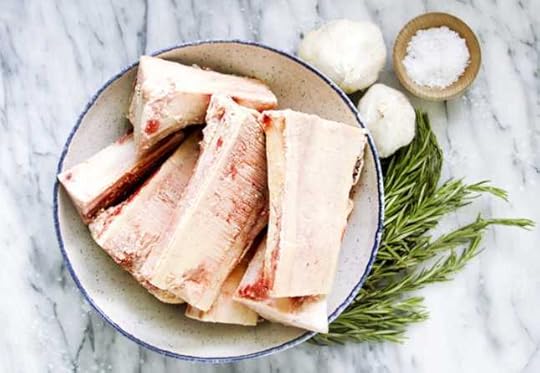
Instructions:
Recipe Note: Some recipes recommend soaking marrow bones in brine (about 2 quarts cold water and ½ cup kosher salt) overnight before roasting. This cleans the bones, removing some of the blood and making the bones look nicer. However, if you buy high-quality, grass-fed bones, brining doesn’t seem to make much of a difference in the flavor or quality of the roasted marrow. Blood spots that come to the surface of the marrow before you cook the bones are perfectly normal, and don’t need to be wiped away.
Preheat oven to 425 °F/218 °C.
Place the bones, marrow side up, on a parchment or foil lined baking sheet. Season the marrow generously with salt. Sprinkle rosemary over the marrow.
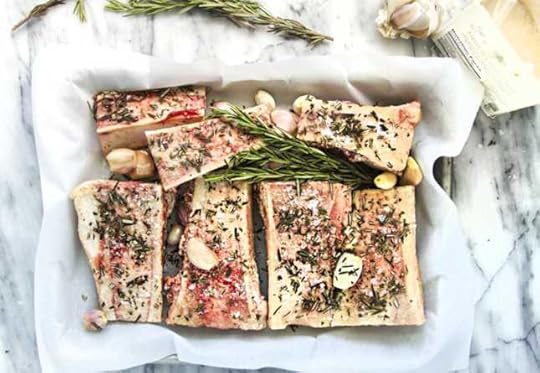
Rub any loose papery skin off the cloves of garlic, but don’t peel the cloves. Trim off both ends of the cloves of garlic. Rub the cloves with a little bit of oil. Scatter the garlic cloves around the bones.
Roast 25 minutes. The marrow should be very soft and warm all the way through and bubbling a little.
Squeeze the garlic cloves out of their peels. Drop the cloves in with the marrow, and eat with a spoon.
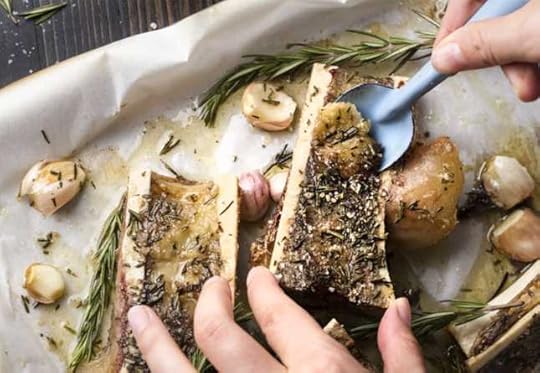
Bonus Recipe: Bone Marrow “Butter”
A great idea for any extra you have left over—bone marrow “butter. Just let the bones cool in the fridge, then scrape out the marrow and herbs into a bowl. Whip for 2 minutes.

Bone marrow butter is great on sweet potato toast or roasted/grilled veggies, but use your imagination to enjoy!
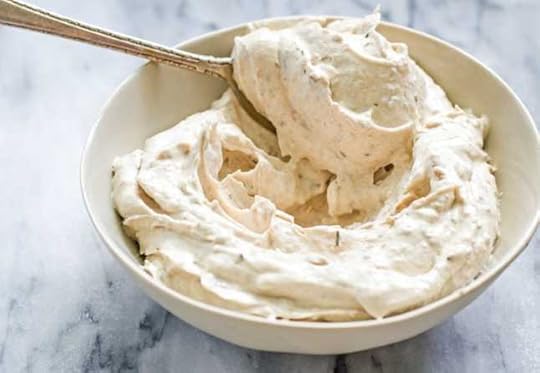

The post Roasted Bone Marrow with Rosemary and Garlic appeared first on Mark's Daily Apple.



October 12, 2018
I Feel Unstoppable
It’s Friday, everyone! And that means another Primal Blueprint Real Life Story from a Mark’s Daily Apple reader. If you have your own success story and would like to share it with me and the Mark’s Daily Apple community please contact me here. I’ll continue to publish these each Friday as long as they keep coming in. Thank you for reading!
 Hi Everyone, my name is Jason. I am 37-years-old. I have a beautiful, brilliant, and ambitious wife, two teenage sons and a 2 1/2-year-old daughter. I am a business executive, entrepreneur, and a life long learner with a master’s degree in management, and not to mention what I consider a pseudo “doctoral degree” in lessons learned the hard way. Driven by my desire to ensure my wife and kids had everything they could ever need or want, not too long ago I changed career fields from not-for-profit to for-profit, moving from social work to the IT world. In three years I went from a consultant position to an executive running the company’s operations. I specialize in engaging people and moving the management systems toward a place of consistency and efficiency while capturing what makes the company tick and not losing that. I am very excited about my work. I enjoy what I do and like that I am able to help the people around me succeed, and as a result they help me.
Hi Everyone, my name is Jason. I am 37-years-old. I have a beautiful, brilliant, and ambitious wife, two teenage sons and a 2 1/2-year-old daughter. I am a business executive, entrepreneur, and a life long learner with a master’s degree in management, and not to mention what I consider a pseudo “doctoral degree” in lessons learned the hard way. Driven by my desire to ensure my wife and kids had everything they could ever need or want, not too long ago I changed career fields from not-for-profit to for-profit, moving from social work to the IT world. In three years I went from a consultant position to an executive running the company’s operations. I specialize in engaging people and moving the management systems toward a place of consistency and efficiency while capturing what makes the company tick and not losing that. I am very excited about my work. I enjoy what I do and like that I am able to help the people around me succeed, and as a result they help me.
While an increase in income had its benefits, it also had adverse effects on my health, which ultimately threatened my ability to enjoy the things I worked the hardest to support. Taking on more and more at the rate I did caused me to constantly live in a state of fight or flight. I worked crazy hours to maintain and never felt at rest.
Having children relatively far apart (my sons in my 20s and my daughter not until my middle 30s) had a major impact on my perspective, and was the true driving force in my choice to search for a healthy lifestyle. I needed to be healthy for a long time to come to see my daughter’s future, walking her down the aisle for example, but having two active teenage boys who were heavily involved in sports meant I also needed to be fit right now as well. Working out historically for me involved long, drawn out hours at the gym, and frankly, took away precious time I could have been spending with my family. I eventually sacrificed my highly time consuming exercise routines and focused on being a business executive, an entrepreneur, and a family man. This inevitably lead to a relatively sedentary lifestyle. Once I had my daughter and my activity decreased, it was obvious that the boys took notice, and they openly expressed how much they missed tossing the football and essentially just playing together.
Being heavily involved in sports since an early age, I was never obese, nor did I ever really struggle in a serious way with my weight. Being in shape and exercising was normal for me.
During 2010 – 2012 I was in peak physical condition, with a lifting routine coupled with biking or running on alternating days. I rarely took a day off, abiding to the ‘no pain no gain’ mindset, and really pushed my body to the limit. My diet consisted of steamed rice, veggies, chicken or fish, and some nuts. I would drink only water, coffee and the occasional ‘light’ beer. As a lover of a good local micro brew from time to time, this was rough. While I saw muscles in the mirror and could run for quite a distance, the LGN factor as Mark calls it, I felt aches and pains all the time. I even ended up with a kidney stone, which was probably the most pain I’ve ever experienced in my life. I really wasn’t even enjoying this ‘healthy lifestyle’! What’s there to enjoy about a bland, boring diet, hours at the gym, and super expensive supplements, to just feel rather mediocre at the end of it all.
 As you can probably guess, I became rather burned out, eventually giving up my rigorous exercise routine and transitioned back to the SAD. I put on a little weight, but nothing shocking, so I didn’t worry. Around 2015 I truthfully stopped working out all together. It didn’t help that when my wife became pregnant in 2016, pizza was all she could tolerate with her severe morning sickness, and I allowed myself to eat as many pepperoni slices as she did.
As you can probably guess, I became rather burned out, eventually giving up my rigorous exercise routine and transitioned back to the SAD. I put on a little weight, but nothing shocking, so I didn’t worry. Around 2015 I truthfully stopped working out all together. It didn’t help that when my wife became pregnant in 2016, pizza was all she could tolerate with her severe morning sickness, and I allowed myself to eat as many pepperoni slices as she did.
I began to notice my mental performance and overall energy levels were low. I was increasingly irritable and found it hard to be patient. I was feeling sick all the time with what seemed to be cold like symptoms. I felt just so heavy and not as physically capable as I once was. At one point I was in the shower and lost consciousness and my wife found me lying down. I was not sure what caused this, but it was very scary and definitely a symptom of declining health. I had a very serious infection that ultimately ended up causing vertigo. After a trip to an urgent care to be checked out, he promptly sent me to the ER for a full work-up due to my family history of stroke and heart disease in conjunction with the scary symptoms I was experiencing. To top it all off, Sophia was born in 2016 and it finally hit me—I had three kids who were all going to need me to be around for a long time. I had gone from 170 lbs to 207 lbs. It was time for a change. Enough was enough.
My wife started a journey of weight loss and self discovery after delivering, and began to research paleo and primal lifestyles. She purchased a copy of The Primal Blueprint, and though I was familiar with Mark’s Daily Apple, I had never really engaged. I picked it up and read it along with another favorite of mine, Dr. Diamond’s Guns, Germs and Steel. I took the next few years doing my own research and fully digesting what it all meant. Watching my wife begin this journey, sampling some of her food, and seeing her energy levels increase along with her overall health improvement, in July of 2018, I decided to dust off our copy of The Primal Blueprint and try the 21-Day Total Body Transformation.
As mentioned earlier, I do have a family history of heart conditions and stroke, so I knew genetics were at play. Knowing what I had read about ancestral health and what Mark refers to as gene expression, I was skeptical that I couldn’t control these systems and even reverse some of them through just eating and living primally.
I chose to dive in to commit. I really engaged in the primal way of eating and I was amazed at my general overall improved health and well being. I almost immediately experienced mental clarity. Tasks that used to overwhelm and frustrate me due to brain fog became trivial and easy to think through. Being fat adapted was key and in a week in I noticed a definite change in my demand for food, especially in the morning. I would start the day with coffee with heavy cream or occasionally a rendition of “Bullet Proof” coffee, and this could take me until 1 p.m. At that point, I would feel a dull signal to eat when possible, but not the crashing hunger or a brain meltdown like I used to have when I was a sugar burner. Being free from the all consuming demand to eat with out of control blood sugar levels and insulin spikes is amazing—I feel like the machine is humming the way it should and I do take comfort in that.
The biggest thing for me in all of this is just once again being able to enjoy life. When I was at my least fit and most unhealthy, my sons commented on missing the days dad was ‘a beast’ or ‘like a super hero’. This hit me hard. I remembered the times I would be climbing the trees in the park with them and how I was able to keep up and not get winded, often getting social media shout-outs from teenage boys on how ‘the old man can keep up!’ I took on more and more professional responsibility and left myself, health, and most importantly what it felt like to just live a thing of the past.
 Mark speaks to the idea of incorporating natural movement into your routine every day. I bought a kid carrier for my mountain bike to pull Sophia. She loves it and my wife joins us as well! I converted my garage into a workout area and invested in some padded floor squares. My son, the wrestler, and my wife, the Martial Artist, especially love this addition. I use this space for my essential movements, lifting heavy and other fitness experiments I find at MDA. I hooked up a sound system for extra motivation during tough workouts, and my daughter particularly loves dancing to Pearl Jam and the Rolling Stones, so everyone wins. I have always enjoyed photography, so I invested in a professional grade camera and now go on nature hikes, scavenging for local flowers and other beautiful wildlife I can catch in the moment. I usually carry a heavy weighted rucksack for added resistance. I now press the record button and chose to watch television shows later in the evening after I have completed a long, challenging but gentle walk, leaving my phone and other distracting devices behind. Being able to disconnect has ironically helped me stay clear minded and level headed during working hours when I need to be connected. I read books, prep meals, and engage in activities that relax and rest my mind, while also challenging it. Speaking of meal prep, I absolutely love the avocado based dressings and Primal Fuel with the Grass-fed Collagen is awesome post workout. Incorporating movement and my newfound healthy lifestyle into my daily rituals and allowing it to also touch my wife and children’s lives is a priceless investment for all of us for years to come.
Mark speaks to the idea of incorporating natural movement into your routine every day. I bought a kid carrier for my mountain bike to pull Sophia. She loves it and my wife joins us as well! I converted my garage into a workout area and invested in some padded floor squares. My son, the wrestler, and my wife, the Martial Artist, especially love this addition. I use this space for my essential movements, lifting heavy and other fitness experiments I find at MDA. I hooked up a sound system for extra motivation during tough workouts, and my daughter particularly loves dancing to Pearl Jam and the Rolling Stones, so everyone wins. I have always enjoyed photography, so I invested in a professional grade camera and now go on nature hikes, scavenging for local flowers and other beautiful wildlife I can catch in the moment. I usually carry a heavy weighted rucksack for added resistance. I now press the record button and chose to watch television shows later in the evening after I have completed a long, challenging but gentle walk, leaving my phone and other distracting devices behind. Being able to disconnect has ironically helped me stay clear minded and level headed during working hours when I need to be connected. I read books, prep meals, and engage in activities that relax and rest my mind, while also challenging it. Speaking of meal prep, I absolutely love the avocado based dressings and Primal Fuel with the Grass-fed Collagen is awesome post workout. Incorporating movement and my newfound healthy lifestyle into my daily rituals and allowing it to also touch my wife and children’s lives is a priceless investment for all of us for years to come.
In the end, once I was able to get over my own analysis paralysis, and simply follow the primal principles, things fell into place. Mark’s references all the time to living 80/20 and really engaging in the rich experience of the journey has made it easy. I feel unstoppable, like I can take on anything life throws my way.
After recently listening to a Primal Blueprint Podcast in which Mark introduces his mantra of ‘Living Awesome!’, it resonated with me, and I truly feel like I am able to live awesome for my family and for my personal and professional goals. This lifestyle has allowed me to be a better husband, father, colleague and have so much more to give in lifting them up in their own goals and life dreams.
Mark’s Primal Blueprint has given myself and many others a second chance at achieving the best versions of ourselves, and it is something that should be shared. I am truly excited to use my newfound health coupled with my business, operational, leadership, and executive skills, with inspiration from the Primal Mission, to inspire others to live their best lives as well. Thank you Mark!


The post I Feel Unstoppable appeared first on Mark's Daily Apple.



October 11, 2018
Is Monk Fruit Sweetener a Healthy Choice?
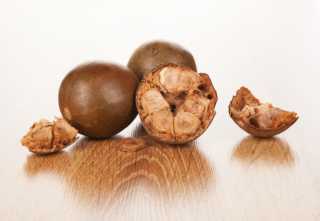 Primal eating for many people means prioritizing whole foods but not entirely eschewing natural sweeteners in the occasional recipe. We’ve covered the likes of stevia, yacon syrup, and Swerve recently, but what about another popular choice in the growing selection of natural sweetners—monk fruit? What is it, and where does it come from? What are the benefits (not to mention risks) that studies point out? And how do we compare the various formulations next to each other in the supermarket aisle? Let’s break this down.
Primal eating for many people means prioritizing whole foods but not entirely eschewing natural sweeteners in the occasional recipe. We’ve covered the likes of stevia, yacon syrup, and Swerve recently, but what about another popular choice in the growing selection of natural sweetners—monk fruit? What is it, and where does it come from? What are the benefits (not to mention risks) that studies point out? And how do we compare the various formulations next to each other in the supermarket aisle? Let’s break this down.
What Is Monk Fruit?
Known as luo han guo in its native southern China, monk fruit (Siraitia grosvenorii) first found acclaim in the records of 13th century Luo Han Buddhist monks. The monks valued the inherent sweetness of the fruit and made it their mission to cultivate the vines through the centuries. Today, most monk fruit cultivation still takes place in the misty mountains of China’s Guangxi province and a few surrounding areas, where the conditions are just right to grow and harvest the small, orange-sized fruits.
Monk fruit belongs to the cucurbit family, alongside the likes of squash, cucumber and watermelon. Fresh off the vine, the mini melons have a bitter outer rind encasing a sweet edible pulp and seeds. But unless you know someone who’s managed to cultivate monk fruit in their garden, you’re unlikely to ever eat a fresh monk fruit. The flesh degrades quickly, meaning most exported monk fruit has been dried and/or processed to ensure longevity.
Thus, most monk fruit finds its way to American shelves as a concentrated natural sweetener. As always, the nature of that sweetener can vary markedly depending on the way in which it was processed. An average serving of pure monk fruit extract contains virtually no carbs, calories or sugars, deriving almost all of its sweetness from a group of antioxidants called mogrosides, with mogroside V having a sweetness 250 times that of sucrose (table sugar).
To put that sweetness in perspective, most people consider just 1/64 of a teaspoon of monk fruit extract to taste as sweet as a full teaspoon of table sugar.
But in order to get this natural “zero calorie” sweetener, much of the inherent compounds in the fruit are lost. Prior to arriving on supermarket shelves, most “pure” monk fruit sweeteners are treated with a solvent to remove off-flavors, evaporated to remove other sulfurous volatiles, homogenized, and pasteurized. The resulting extract is very different to its original state, slightly undermining its purported status as a natural sweetener.
Other less processed natural monk fruit sweeteners provide a more wholesome version of the original fruit, but with the arguable downside of containing a small amount of glucose and fructose. More carbs also tend to mean fewer mogrosides, and hence a lower relative sweetness.
Monk Fruit’s Nutritional Profile
Contrary to what people might claim, fresh, unprocessed monk fruit is not sugar free – figures vary between cultivar and growing region, but fresh monk fruit is typically one third carbohydrate, composed of a mix of fructose and glucose.
With the extraction of the juice, however, much of those carbs are left behind. At this point, a minimally-processed monk fruit extract sweetener might only contain small amounts of sugars in the form of fructose or glucose, at which point it becomes a low-calorie natural sweetener. A half teaspoon serving of this monk fruit juice powder, for example, is made up of 10% sugar, with the rest of the carbs presumably being composed of mogrosides and other unfermentable sweet-tasting compounds.
At the other end of the scale, pure monk fruit extracts such as this one truly are zero-calorie sweeteners, with no carbs and no sugars. Manufacturers are sometimes hesitant to sell straight monk fruit extract, however, because of the common“off flavors,” choosing instead to mix in small amounts of other sweeteners like erythritol or stevia. It’s not uncommon to find sucrose or dextrose lurking on the ingredients list of so-called natural monk fruit sweeteners, but the amounts would be pretty minimal.
While monk fruit contains several different mogrosides, the key ingredient is generally mogroside V. This is easily the sweetest-tasting of all the compounds in monk fruit, and very conveniently it isn’t metabolized in the same fashion as simple sugars like glucose or fructose. Mogroside V tends to be poorly absorbed within the digestive system. This accounts for the “zero calorie” claims of monk fruit extract products, and spells good news for those looking to satiate their sweet tooth while avoiding calorie loading or blood sugar spikes.
Potential Health Benefits Of Monk Fruit
While the extraction and refining processes remove most of the original natural compounds from fresh monk fruit, research indicates that the mogrosides and other flavonoids that remain can still impact health. Here’s a brief look at some of the benefits (preventative and otherwise) you might enjoy using monk fruit sweeteners.
Anti-Obesity Effects
As Primal folks know, sugar (not fat) is the leading dietary cause of the obesity epidemic. And as the world has ever-so-slowly awakened to the notion that sugar might be doing the most damage, there’s been a push towards sweeteners that don’t elicit the same insulin-meddling, inflammation-elevating, liver-damaging effects as sugar. Preliminary evidence suggests that the mogrosides in monk fruit sweeteners might be just the ticket. A 2012 study showed that total mogrosides extracted from monk fruit “suppressed the increase in body weight, abdominal and epididymal fats weight” in mice placed on a high fat diet (presumably not good fats). Another study published this year once again showed that obese mice fed mogrosides from monk fruit had significantly reduced body and liver weights compared to control mice. It was thought that the mogrosides achieved this anti-obesity effect by “enhancing fat metabolism and antioxidative defenses”.
Obviously, more research is needed to verify these findings, especially in humans. But its a promising start.
Anti-Diabetic Applications
Unsurprisingly, there’s been plenty of research into the potential antidiabetic effect of mogrosides found in monk fruit sweeteners. In one study, mogroside extracts from monk fruit administered to diabetic rats significantly eased symptoms and protected against biochemical abnormalities. In another, diabetic rats were fed monk fruit extract for 13 weeks. Those rats fed the monk fruit extract showed improved insulin response, along with reduced blood sugar levels after glucose administration and a reduction in oxidative stress caused by the diabetes. What’s more, the monk fruit group also showed signs of lowered kidney damage, a common symptom of advanced diabetes.
Yet another study showed that both crude monk fruit extract and mogroside V helped to stimulate the secretion of insulin in pancreatic beta cells.
You get the idea. Once again, more studies in humans are needed to make any definitive conclusions.
Anti-Carcinogenic Benefits
While studies are very much in their infancy regarding the negative link between the antioxidants in monk fruit and cancer, there’s likely to be more on the horizon. A 2016 study used mogroside IV, extracted from monk fruit, to inhibit the proliferation of both colorectal and throat cancer cells and suppress tumor growth. An earlier study showed that a range of triterpenoids (including several mogrosides) isolated from monk fruit showed “potent inhibitory effects” on Eppstein-Barr Virus-induced tumor growth. This strong anti-carcinogenic effect was further verified by a subsequent study.
This actually makes plenty of sense, as multiple studies have highlighted the antioxidant and free radical-scavenging powers of mogrosides found in monk fruit sweeteners.
Anti-Inflammatory Effects
A 2011 study indicated that mogrosides administered to mice significantly reduced inflammation by down-regulating pro-inflammatory genes and up-regulating anti-inflammatory genes. That’s a lot of hyphens….
A more recent study demonstrated the ability of mogroside V to lower induced lung inflammation in mice by more than half. From a slightly more tangential perspective, researchers have also shown that monk fruit extracts reduce physical fatigue in mice (allowing them to swim for longer). This anti-fatigue effect is undoubtedly due, at least in part, to monk fruit’s tendency to lower inflammation.
Pro-Immunity Benefits
The health-giving powers of monk fruit sweeteners may even extend to immune function. In one study, groups of diabetic mice were fed either low-dose mogrosides, high-dose mogrosides, or a saline control solution over the course of a month. At the end of the trial, both mogroside groups (but particularly the low-dose group) showed significant protection against diabetes-induced immune dysfunction. Interestingly, this immune-bolstering effect was only apparent in immune-suppressed diabetic mice, suggesting it plays an important role in restoring homeostasis in the body.
This pro-immunity effect is further solidified by the fact that certain monk fruit isolates have anti-bacterial properties, and can prevent the growth of common bacterial pathogens like Streptococcus mutans, Porphyromonas gingivalis and Candida albicans.
Are Monk Fruit Sweeteners Safe?
While long-term, multi-year toxicity trials are notably lacking, no trials have yet revealed anything of concern. For what it’s worth, the FDA gave monk fruit products their GRAS seal of approval in 2010, and it’s of some note that monk fruit has been cultivated and eaten since at least the 13th century, albeit at far lower concentrations.
Limited trials in humans haven’t reported any adverse side effects, and a study in mice showed that, even at ridiculously high dosages, no toxic or mutagenic effects were observed. That being said, the use of highly concentrated monk fruit sweeteners is very much in its infancy. Moderation is a safe bet.
Tips For Buying and Using Monk Fruit Sweeteners
Which product you choose will depend on your preference. Those who prefer an entirely non-caloric formulation will want to go with pure monk fruit extract. Or you may prioritize less-processed versions, which might contain a small amount of simple sugars and a little less mogrosides. At the other end of the spectrum, those who don’t particularly like the aftertaste of monk fruit extract might opt for a blended product that also includes the likes of erythritol, xylitol, and/or stevia.
While most people enjoy the taste of monk fruit, it’s not necessarily for everyone. Taste descriptors vary markedly from person to person, with some noting it tastes like caramel or molasses, others more like a sweet licorice. Keep in mind that the more refined the monk fruit sweetener, the blander and sweeter it will taste.
And speaking of sweetness, remember that mogroside V, the key ingredient in most monk fruit sweeteners, is up to 250 times sweeter than sugar, so a little goes a very long way. Most labels provide a sugar substitution guide for recipes.
How you use monk fruit sweeteners will also depend on your taste preferences. Some common uses include:
baked goods
sauces and salad dressings
teas
fruit/vegetable-based drinks
smoothies
Asian dishes that call for a dash of sweetness
That’s just the beginning, really. Experiment, and see how it might work for you and your family.
Thanks for stopping by, folks. Have you used monk fruit as a sweetener, or would you consider trying it? Be sure to share your thoughts below.

References:
Lim, T. K. Siraitia grosvenorii. Edible Medicinal And Non-Medicinal Plants, pp 392-400.
Tomicic MT. Replica to the Opinion Letter regarding the article “Sensitization of colorectal cancer cells to irinotecan by the Survivin inhibitor LLP3 depends on XAF1 proficiency in the context of mutated p53” (Arch Toxicol https://doi.org/10.1007/s00204-018-240-x). Arch Toxicol. 2018;92(10):3243-3244.
Itkin et al. The biosynthetic pathway of the nonsugar, high-intensity sweetener mogroside V from Siraitia grosvenorii. PNAS November 22, 2016 113 (47)
Shen et al. Rapid identification and quantification of five major mogrosides in Siraitia grosvenorii (Luo-Han-Guo) by high performance liquid chromatography–triple quadrupole linear ion trap tandem mass spectrometry combined with microwave-assisted extraction. Microchemical Journal, Volume 116, September 2014, Pages 142-150.
Luo et al. In vitro AMPK activating effect and in vivo pharmacokinetics of mogroside V, a cucurbitane-type triterpenoid from Siraitia grosvenorii fruits. RSC Advances. 6(9):7034.
Xu F, Li DP, Huang ZC, et al. Exploring in vitro, in vivo metabolism of mogroside V and distribution of its metabolites in rats by HPLC-ESI-IT-TOF-MS(n). J Pharm Biomed Anal. 2015;115:418-30.
Sun et al. Anti-obesity effects of mogrosides extracted from the fruits of Siraitia grosvenorii (Cucurbitaceae). African Journal of Pharmacy and Pharmacology. 2012;6(20):1492.
Zhang X, Song Y, Ding Y, et al. Effects of Mogrosides on High-Fat-Diet-Induced Obesity and Nonalcoholic Fatty Liver Disease in Mice. Molecules. 2018;23(8):1894.
Suzuki YA, Tomoda M, Murata Y, Inui H, Sugiura M, Nakano Y. Antidiabetic effect of long-term supplementation with Siraitia grosvenori on the spontaneously diabetic Goto-Kakizaki rat. Br J Nutr. 2007;97(4):770-5.
Zhou Y, Zheng Y, Ebersole J, Huang CF. Insulin secretion stimulating effects of mogroside V and fruit extract of luo han kuo (Siraitia grosvenori Swingle) fruit extract. Yao Xue Xue Bao. 2009;44(11):1252-7.
Liu C, Dai L, Liu Y, et al. Antiproliferative Activity of Triterpene Glycoside Nutrient from Monk Fruit in Colorectal Cancer and Throat Cancer. Nutrients. 2016;8(6):360.
Ukiya et al. Inhibitory Effects of Cucurbitane Glycosides and Other Triterpenoids from the Fruit of Momordica grosvenori on Epstein?Barr Virus Early Antigen Induced by Tumor Promoter 12-O-Tetradecanoylphorbol-13-acetate. Journal of Agricultural and Food Chemistry 2002 50 (23), 6710-6715
Takasaki et al. Anticarcinogenic activity of natural sweeteners, cucurbitane glycosides, from Momordica grosvenori. Cancer Letters. 2003. 198(1):37.
Chen et al. The antioxidant activities of natural sweeteners, mogrosides, from fruits of Siraitia grosvenori. International Journal of Food Sciences and Nutrition. 2007 Volume 58, Issue 7.
Qi XY, Chen WJ, Zhang LQ, Xie BJ. Mogrosides extract from Siraitia grosvenori scavenges free radicals in vitro and lowers oxidative stress, serum glucose, and lipid levels in alloxan-induced diabetic mice. Nutr Res. 2008;28(4):278-84.
Di et al. Anti-inflammatory Activities of Mogrosides from Momordica grosvenoriin Murine Macrophages and a Murine Ear Edema Model. J. Agric. Food Chem., 2011, 59 (13), pp 7474–7481
Dongfang Shi, Meizhu Zheng, Yumeng Wang, Chunming Liu & Shan Chen (2014) Protective effects and mechanisms of mogroside V on LPS-induced acute lung injury in mice, Pharmaceutical Biology, 52:6, 729-734
Liu DD, Ji XW, Li RW. Effects of Siraitia grosvenorii Fruits Extracts on Physical Fatigue in Mice. Iran J Pharm Res. 2013;12(1):115-21.
Chen et al. Effects of Mogroside Extract on Cellular Immune Function in Alloxan-Induced Diabetic Rats. Acta Nutrimenta Sinica, 2006-03.
Zheng Y, Liu Z, Ebersole J, Huang CB. A new antibacterial compound from Luo Han Kuo fruit extract (Siraitia grosvenori). J Asian Nat Prod Res. 2009;11(8):761-5.
Al Li-Ping. Acute Toxicity and Mutagenicity of Siraitia grosvenorii Extract in Mice. Journal of Anhui Agricultural Sciences. 2014-03.
The post Is Monk Fruit Sweetener a Healthy Choice? appeared first on Mark's Daily Apple.



October 10, 2018
A Primal Guide to Prostate Health
 Many of you have asked about prostate health in a Primal context. Men are interested because they know men have a decent chance of getting prostate cancer. Women are interested because they’re worried about the men in their lives getting prostate cancer. Today, I’m going to delve deep into the topic, exploring the utility (or lack thereof) of standard testing, the common types of treatment and their potential efficacy, as well as preventive and unconventional ways of reducing your risk and mitigating the danger of prostate cancer.
Many of you have asked about prostate health in a Primal context. Men are interested because they know men have a decent chance of getting prostate cancer. Women are interested because they’re worried about the men in their lives getting prostate cancer. Today, I’m going to delve deep into the topic, exploring the utility (or lack thereof) of standard testing, the common types of treatment and their potential efficacy, as well as preventive and unconventional ways of reducing your risk and mitigating the danger of prostate cancer.
Let’s go.
First, what does the prostate do, anyway? Most people only think about it in terms of prostate cancer.
It’s a gland about the size of a small apricot that manufactures a fluid called prostatic fluid that combines with sperm cells and other compounds to form semen. Prostatic fluid protects sperm against degradation, improves sperm motility, and preserves sperm genetic stability.
What Goes Wrong With the Prostate?
There are a few things that can happen.
Prostatitis
Inflammation of the prostate, usually chronic and non-bacterial. A history of prostatitis is a risk factor for prostate cancer.
Benign Prostatic Hyperplasia
Non-cancerous enlargement of the prostate. As men age, the prostate usually grows in size. This isn’t always cancer but can cause similar symptoms.
Prostate Cancer
What most of us are interested in when we talk about prostate health… After skin cancer, prostate cancer is the most common cancer among men and the sixth most common cause of cancer death among men worldwide. Yet, most men diagnosed with prostate cancer do not die from it; they die with it. The 5-year survival rate in the US is 98%.
That said, there is no monolithic “prostate cancer.” Like all other cancers, there are different grades and stages of prostate cancer. Each grade and stage has a different mortality risk:
Low-grade prostate cancer grows more slowly and is less likely to spread to other tissues.
High-grade prostate cancer grows more quickly and is more likely to spread to other tissues.
Local prostate cancer is confined to the prostate. The 5-year relative survival rate (survival compared to men without prostate cancer) for local prostate cancer is almost 100%.
Regional prostate cancer has spread to nearby tissues. The 5-year relative survival rate for regional prostate cancer is almost 100%.
Distant prostate cancer has spread to tissues throughout the body. The 5-year relative survival rate for distant prostate is 29%. Distant prostate cancer explains most of the prostate-related mortality.
What Are Symptoms of Prostate Cancer?
The primary symptom is problems with urination. When the prostate gland grows, it has the potential to obstruct the flow of urine out of the bladder, causing difficulty urinating, weak urine flow, painful urination, or frequent urination. This can also be caused by benign prostatic hyperplasia, a non-cancerous enlargement of the prostate.
What Causes Prostate Cancer?
A big chunk is genetic. People with “knockout” alleles for BRCA, which codes for tumor suppression, have an elevated risk of some forms of prostate cancer. That’s the same one that confers added risks for breast cancer.
Ethnicity matters, too. Men of Sub-Saharan African descent, whether African-Americans in the U.S. or Caribbean men in the U.K., have the highest risk in the world for prostate cancer—about 60% greater than other ethnic groups. White men have moderate risks; South Asian, East Asian, and Pacific Islander men have lower risks.
Testosterone has a confusing relationship with prostate cancer. Conventional wisdom tends to hold that testosterone stimulates prostate cancer growth, and there’s certainly some evidence of a relationship, but it’s not that simple.
In one study, men with low free testosterone levels were less likely to have low-grade (less risk of spreading) prostate cancer but more likely to have high-grade (higher risk of spreading) prostate cancer.
In another, testosterone deficiency predicted higher aggressiveness in localized prostate cancers.
In Chinese men, those who went into treatment with low testosterone were more likely to present with higher-grade localized prostate cancers.
Other studies have arrived at similar results, finding that “hypogonadism represents bad prognosis in prostate cancer.”
Many prostate cancer treatments involve testosterone deprivation, a hormonal reduction of testosterone synthesis. This can reduce symptoms and slow growth of prostate tumors during the metastatic phase, but prostate cancer tends to be highly plastic, with the ability to adapt to changing hormonal environments. These patients often see the cancer return in a form that doesn’t require testosterone to progress.
What About Testing?
If you have a prostate, should you get tested starting at age 40?
Not necessarily. The value of early testing hasn’t been established. Some researchers even question whether early testing is more harmful than ignoring it, and most of the research finds middling to nonexistent evidence in favor of broad testing for everyone. Early testing has a small effect on mortality from prostate cancer, but no effect on all-cause mortality.
PSA testing can also be inaccurate. PSA is prostate specific antigen, a protein produced by the prostate. It’s normal to have low levels of PSA present in the body, and while high levels of PSA are a good sign of prostate cancer—even years before it shows up in imaging or digital probes—they can also represent a false positive. Those two other common yet relatively benign prostate issues—benign hyperplasia and prostatitis—can also raise PSA levels well past the “cancer threshold.”
Other causes of high levels of PSA include:
Urinary tract infections
Recent sex or ejaculation
Recent, vigorous exercise
Certain medications.
In fact, if you have a PSA reading of 4 (the usual threshold), there’s still just a 30% chance it actually indicates cancer.
What About Treatment?
Let’s say you do have prostate cancer, confirmed by PSA and a biopsy (or two, or three, as needle biopsies often miss cancers). What next? Should you definitely treat it?
It’s unclear whether treatment improves survival outcomes. One study took men aged 50-69 with prostate cancer diagnosed via PSA testing, divided them among three treatment groups, and followed them for ten years. One group got active monitoring—they continued to test and monitor the status of the cancer. One group received radiotherapy—radiation therapy to destroy the tumor. And the last group had the cancer surgically removed. After ten years, there was no difference among the groups for all-cause mortality, even though the active-monitoring group saw higher rates of prostate cancer-specific deaths (8 deaths—in a group of 535 men— vs 5 in the surgery group and 4 in the radiotherapy group), cancer progression, and metastasis.
In another study of men with localized prostate cancer, removing the prostate only improved all-cause mortality rates among men with very high PSAs (more than 10). In men with lower PSAs, “waiting and seeing” produced similar outcomes as surgery.
Prostate removal also carries many unwanted side effects, like incontinence and sexual dysfunction. No one wants prostate cancer, but it’s no small thing to have problems with urination and sex for the rest of your life. Those are major aspects of anyone’s quality of life.
Before you make any decisions, talk to your doctor about your options, the relative mortality risk of your particular cancer’s stage and grade, and how the treatments might affect your quality of life.
How Can You Reduce the Risk of Prostate Cancer?
1. Inflammation is definitely an issue.
For one, there’s the relationship between prostatitis, or inflammation of the prostate, and prostate cancer that I already mentioned above.
Two, there’s the string of evidence linking anti-inflammatory compounds to reductions in prostate cancer incidence. For example, aspirin cuts prostate cancer risk. Low-dose aspirin (under 100 mg) reduces both the incidence of regular old prostate cancer and the risk of metastatic prostate cancer. It’s also associated with longer survival in patients with prostate cancer; other non-steroidal anti-inflammatories are not.
Third, anti-inflammatory omega-3 fatty acids (found in seafood and fish oil) are generally linked to lower rates of prostatic inflammation and a less carcinogenic environment; omega-6 fatty acids can trigger disease progression. A 2001 study of over 6,000 Swedish men found that the folks eating the most fish had drastically lower rates of prostate cancer than those eating the least. Another study from New Zealand found that men with the highest DHA (an omega-3 found in fish) markers slashed their prostate cancer risk by 38% compared to the men with the lowest DHA levels.
2. The phytonutrients you consume make a difference.
A series of studies on phytonutrient intake and prostate cancer incidence in Sicilian men gives a nice glimpse into the potential relationships:
The more polyphenols they ate, the less prostate cancer they got.
The more phytoestrogens they ate, the more prostate cancer they got. Except for genistein, an isoflavone found in soy and fava beans, which was linked to lower rates of prostate cancer. The Sicilians are eating more fava than soy, I’d imagine.
How about coffee, the richest source of polyphenols in many people’s daily diets? It doesn’t appear to reduce the incidence of prostate cancer, but it does predict a lower rate of fatal prostate cancer.
3. Your circadian rhythm and your sleep are important.
Like everything else in life, tumor suppression follows a circadian pattern. Nighttime melatonin—which is suppressed if your sleep hygiene is bad and optimal if your sleep hygiene is great—inhibits the growth of prostate cancer cells and reduces their ability to utilize glucose. One way to enhance nighttime melatonin is by getting plenty of natural, blue light during the day; this actually makes nighttime melatonin more effective at prostate cancer inhibition. On the other hand, getting that blue light at night is a major risk factor for prostate cancer.
4. Get a handle on your fasting blood sugar and insulin.
In one study, having untreated diabetic-level fasting blood sugar was a strong risk factor for prostate cancer. Another study found that insulin-lowering metformin reduced the risk, while an anti-diabetic drug that raised insulin increased the risk of prostate cancer. Metformin actually lowers PSA levels, which, taken together with the previous study, indicates a causal effect.
5. Keep moving, keep playing, keep lifting.
This has a number of pro-prostate effects:
It keeps you insulin sensitive, so neither fasting insulin, nor fasting glucose get into the danger zone.
If you’re doing testosterone suppression treatment, exercise can maintain (and even increase) your muscle mass, improve your quality of life, and increase your bone mineral density.
Oh, and do some deadlifts. Men with prostate cancer who trained post-surgery had better control over their bodily functions, as long as they improved their hip extensor strength. If you don’t know, hip extension is the act of standing up straight, of moving from hip flexion (hip hinging, bending over) to standing tall. It involves hamstrings, glutes, and the entire posterior chain. Deadlifts are the best way to train that movement pattern.
The prostate cancer issue is frightening because it’s so common. Almost all of us probably know someone who has or had it, even unknowingly. But the good news is that most prostate cancers aren’t rapidly lethal. Many aren’t lethal at all. So whatever you do, don’t rush into serious treatments or procedures without discussing the full range of options in a frank, honest discussion with your doctor.
That’s it for today, folks. Thanks for reading. If you have any questions, comments, or concerns about prostate cancer, feel free to chime in down below. I’d love to hear from you.

References:
Perletti G, Monti E, Magri V, et al. The association between prostatitis and prostate cancer. Systematic review and meta-analysis. Arch Ital Urol Androl. 2017;89(4):259-265.
Ilic D, Djulbegovic M, Jung JH, et al. Prostate cancer screening with prostate-specific antigen (PSA) test: a systematic review and meta-analysis. BMJ. 2018;362:k3519.
Brawer MK, Chetner MP, Beatie J, Buchner DM, Vessella RL, Lange PH. Screening for prostatic carcinoma with prostate specific antigen. J Urol. 1992;147(3 Pt 2):841-5.
Castro E, Eeles R. The role of BRCA1 and BRCA2 in prostate cancer. Asian J Androl. 2012;14(3):409-14.
Watts EL, Appleby PN, Perez-cornago A, et al. Low Free Testosterone and Prostate Cancer Risk: A Collaborative Analysis of 20 Prospective Studies. Eur Urol. 2018;
Neuzillet Y, Raynaud JP, Dreyfus JF, et al. Aggressiveness of Localized Prostate Cancer: the Key Value of Testosterone Deficiency Evaluated by Both Total and Bioavailable Testosterone: AndroCan Study Results. Horm Cancer. 2018;
Dai B, Qu Y, Kong Y, et al. Low pretreatment serum total testosterone is associated with a high incidence of Gleason score 8-10 disease in prostatectomy specimens: data from ethnic Chinese patients with localized prostate cancer. BJU Int. 2012;110(11 Pt B):E667-72.
Teloken C, Da ros CT, Caraver F, Weber FA, Cavalheiro AP, Graziottin TM. Low serum testosterone levels are associated with positive surgical margins in radical retropubic prostatectomy: hypogonadism represents bad prognosis in prostate cancer. J Urol. 2005;174(6):2178-80.
Banerjee PP, Banerjee S, Brown TR, Zirkin BR. Androgen action in prostate function and disease. Am J Clin Exp Urol. 2018;6(2):62-77.
Zhou CK, Daugherty SE, Liao LM, et al. Do Aspirin and Other NSAIDs Confer a Survival Benefit in Men Diagnosed with Prostate Cancer? A Pooled Analysis of NIH-AARP and PLCO Cohorts. Cancer Prev Res (Phila). 2017;10(7):410-420.
Russo GI, Campisi D, Di mauro M, et al. Dietary Consumption of Phenolic Acids and Prostate Cancer: A Case-Control Study in Sicily, Southern Italy. Molecules. 2017;22(12)
Russo GI, Di mauro M, Regis F, et al. Association between dietary phytoestrogens intakes and prostate cancer risk in Sicily. Aging Male. 2018;21(1):48-54.
Discacciati A, Orsini N, Wolk A. Coffee consumption and risk of nonaggressive, aggressive and fatal prostate cancer–a dose-response meta-analysis. Ann Oncol. 2014;25(3):584-91.
Dauchy RT, Hoffman AE, Wren-dail MA, et al. Daytime Blue Light Enhances the Nighttime Circadian Melatonin Inhibition of Human Prostate Cancer Growth. Comp Med. 2015;65(6):473-85.
Kim KY, Lee E, Kim YJ, Kim J. The association between artificial light at night and prostate cancer in Gwangju City and South Jeolla Province of South Korea. Chronobiol Int. 2017;34(2):203-211.
Murtola TJ, Vihervuori VJ, Lahtela J, et al. Fasting blood glucose, glycaemic control and prostate cancer risk in the Finnish Randomized Study of Screening for Prostate Cancer. Br J Cancer. 2018;118(9):1248-1254.
Haring A, Murtola TJ, Talala K, Taari K, Tammela TL, Auvinen A. Antidiabetic drug use and prostate cancer risk in the Finnish Randomized Study of Screening for Prostate Cancer. Scand J Urol. 2017;51(1):5-12.
Park JS, Lee KS, Ham WS, Chung BH, Koo KC. Impact of metformin on serum prostate-specific antigen levels: Data from the national health and nutrition examination survey 2007 to 2008. Medicine (Baltimore). 2017;96(51):e9427.
Galvão DA, Taaffe DR, Spry N, Joseph D, Newton RU. Combined resistance and aerobic exercise program reverses muscle loss in men undergoing androgen suppression therapy for prostate cancer without bone metastases: a randomized controlled trial. J Clin Oncol. 2010;28(2):340-7.
Ying M, Zhao R, Jiang D, Gu S, Li M. Lifestyle interventions to alleviate side effects on prostate cancer patients receiving androgen deprivation therapy: a meta-analysis. Jpn J Clin Oncol. 2018;48(9):827-834.
Uth J, Fristrup B, Haahr RD, et al. Football training over 5 years is associated with preserved femoral bone mineral density in men with prostate cancer. Scand J Med Sci Sports. 2018;28 Suppl 1:61-73.
Park J, Yoon DH, Yoo S, et al. Effects of Progressive Resistance Training on Post-Surgery Incontinence in Men with Prostate Cancer. J Clin Med. 2018;7(9)
The post A Primal Guide to Prostate Health appeared first on Mark's Daily Apple.



October 9, 2018
Top 9 Keto Apps
 I’m not a big app guy, instead preferring to keep a loose running tally of how I’m eating, training, and living, but my understanding is that kids these days love smartphone apps. Besides, I often forget that not everyone lives and breathes this stuff. Not everyone geeks out over all the minutiae and maintains an extensive database of keto and Primal-related errata in their heads.
I’m not a big app guy, instead preferring to keep a loose running tally of how I’m eating, training, and living, but my understanding is that kids these days love smartphone apps. Besides, I often forget that not everyone lives and breathes this stuff. Not everyone geeks out over all the minutiae and maintains an extensive database of keto and Primal-related errata in their heads.
So today, I’m giving you a list of the top 9 keto (and keto-relevant) apps.
CRON-O-Meter
I actually do keep this one on my phone. CRON-O-Meter (iOS, Android) draws on the latest USDA databases for nutritional info to help you track calories, micronutrients (including vitamins and minerals) and macronutrients (including specific amino acids, fatty acids, and carbohydrates) to plot them against the RDAs and see how much each food contributes. It keeps a running tally of everything you eat and gives you the lowdown on how close you are to fulfilling the RDAs for each nutrient. If you use the same email to login, you can access your account on your desktop, too.
While its intended audience is the CRON (calorie restriction with optimal nutrition) crowd, most of whom tend to be vaguely plant-based, the app is just a solid nutrition tracker that provides a lot of detailed information relevant to any type of eater, including keto dieters. It’s fun to enter a half a pound of beef liver and see your vitamin A, folate, and B-vitamin requirements instantly satisfied. The barcode scanner also works really well.
Keto dieters tend to focus only on macros—on carbs, protein, and fat—and ignore the micronutrients. This is the wrong course to take, and CRON-O-Meter will help you get your micros in order. Wondering about your potassium or magnesium or folate? It’s also good for carb counting, even if that’s not the express purpose of the app.
Only drawback is that it doesn’t track iodine or vitamin K2. USDA databases, start analyzing those nutrients!
Wholesome
Wholesome (iOS) is like CRON-O-Meter except it has better photos, it tracks phytonutrients like resveratrol and curcumin, and it’s clunkier. The photo-based interface, while nice, actually throws me off a bit. I just prefer text. If you’re more of a visual person, you’ll probably love Wholesome.
I will admit that it’s very cool to see how much L-dopa my food contains.
Carb Manager
Folks in the Primal Blueprint Keto Reset Facebook Group love Carb Manager (iOS, Android). It’s self-explanatory. Manage your carbs. The paid version gives you full access to micronutrient data.
I prefer CRON-O-Meter myself, but then again I like to geek out on micronutrients. If you like a slick interface and good functionality, Carb Manager might be the ticket.
Paleo (io)
How many times have you uttered the words, “Is it paleo?” How often does someone who knows you as the resident Primal expert ask it of you?
This is probably old hat to most of you. You can probably scan an aisle of food and immediately analyze the paleo-ness of the ingredients, complete with Terminator-style HUD readouts. Many of you have the answers.
It’s easy to forget how confusing this stuff can be to beginners. Paleo (io) (iOS, Android) answers “Is it paleo?” with a simple “yes” or “no.” Enter the food in question, get the answer. You can also search the app’s paleo food database of over 3000 foods to get more information.
I highly recommend beginners who want to stay keto and honor their biology while hewing to a Primal eating lens combine one of the food database apps like CRON-O-Meter or Carb Manager with Paleo (io). Use the various food trackers to check the carb count of your food, then run that through a Paleo (io) filter.
Senza
Senza (iOS, Android) is a decent introductory guide to keto with a good macro tracker. That’s its main claim to fame. It’s not why I’m recommending it, though (my Keto Reset is a bit better, if you ask me). I’m recommending it because of the 2000-strong recipe database.
I haven’t read through every last one. I’m sure there are some duds, maybe a few Splenda-bombs. The ones I did see looked great, and you can’t beat being able to whip out your phone at the grocery store at 5 P.M. with dinner fast approaching, select an app, and draw on hundreds of recipes to come up with a game plan.
KetoSense
This isn’t actually available yet. According to the iOS app store, the expected release date is October 14, 2018. But the premise is really cool: Search for keto-friendly menu items at restaurants near you. Sort of a “keto Yelp.’
If it works out, and it can actually pull enough data from restaurants, it should be a very useful app to have around.
Elite HRV
Why heart rate variability? What does this Elite HRV (iOS, Android) have to do with going keto?
HRV tracks stress resilience and recovery. If HRV is low, you’re probably worn out, overtrained, and overextended. If HRV is high, you’re probably full of energy, well-recovered, and well-balanced. A low HRV can mean that you’re training too much (or even too little, as regular physical activity increases stress resilience), and it almost certainly indicates that your diet and activity levels are mismatched.
Keto can be tricky for people used to training heavy, hard, and high-volume, at least when they’re first starting out. Tracking your HRV can help you figure out just how hard to go without derailing your diet—or how keto to go without derailing your training.
You do need an external heart rate monitor for this one.
HRV4Training
The beauty of HRV4Training (iOS) is that it uses the phone’s camera to track your HRV. Not quite as accurate as the HRV apps that use external monitors, but close enough to give you good data, especially if you track it consistently and observe the trends. You can’t beat the convenience.
Zero
Keto and fasting go hand in hand. When you go keto (or even just low-carb Primal), fasting just kinda… happens. Your ghrelin drops, you eat more fat and protein, you eat more nutrient-dense foods, you get incredibly adept at burning your own body fat, and all of a sudden you’re going longer between meals, and sometimes skipping them because you simply aren’t hungry. That’s fasting.
Zero (iOS) is a fasting tracker. You choose the fasting regimen you prefer—16-hour long fast, a “circadian rhythm fast,”or create your own schedule, then hit “start” and hit “stop” when you eat something. Over time, you accumulate reams of exportable data, which you can plot against bodyweight changes and relevant health markers to spot trends and identify connections.
Android users can try Vora.
What about MyFitnessPal?
Although I know it’s popular, I’d avoid MyFitnessPal. Its popularity is actually the root of the issue: because so many people use it, the nutritional database has become corrupted by inaccurate or incomplete user submissions. Stick with something like CRON-O-Meter that uses primarily the USDA and other official nutrient databases, unless maybe you’re only using it for macros.
That’s it for today, folks. Those are my 9 top Keto or Keto-related smartphone apps. What are yours?

The post Top 9 Keto Apps appeared first on Mark's Daily Apple.



October 8, 2018
Dear Mark: Air-Frying, “Primal” Vegan-ish, Perfect Heath Diet, and Bad Rep or Rap
 For today’s edition of Dear Mark, I’m answering four questions. First, is air-frying gentler than deep-frying? Does it produce less acrylamide? Second, what do I think of a reader’s Primal-style plant-based way of eating? It’s actually quite good. Third, why didn’t I mention the Perfect Health Diet in last week’s post on top trending diets? And last, did I make a typo or grammatical error when I wrote “bad rap”?
For today’s edition of Dear Mark, I’m answering four questions. First, is air-frying gentler than deep-frying? Does it produce less acrylamide? Second, what do I think of a reader’s Primal-style plant-based way of eating? It’s actually quite good. Third, why didn’t I mention the Perfect Health Diet in last week’s post on top trending diets? And last, did I make a typo or grammatical error when I wrote “bad rap”?
Let’s find out:
Russian squat thing is great.
Anyone know if air frying potatoes creates acrylamide to the same degree normal deep frying does?
Wasn’t it? It’ll obviously never happen around here, and it would raise all sorts of civil rights issues if adopted across the board, but man would it be effective.
Turns out that air-frying is way more gentle on potatoes than deep-frying. Compared to deep-frying, air-frying potatoes reduced acrylamide formation by 90%.
And if you “pre-treated” the potatoes with a solution of nicotinic acid, citric acid, glycine, and salt, you’d get a further reduction of 80-90%.
I don’t know. The initial 90% sounds good enough that I’d hold off on that strange pre-treatment. In fact, I bet you could get a decent approximation of the benefits with a simple marinade on the potatoes. Maybe lemon juice and thyme?
Great round up Mark!
I’m just wondering what you think of a very ‘primal’ 95% vegan like diet?
I have Chron’s disease, but despite the data showing a carnivorous diet helps IBD I have found through a lot of trial and error I cannot handle cooked muscle or organ meat of any kind without a lot of pain.
I eat a vast variety of gently cooked vegetables, massaged salads, cooked and cooled legumes (also potatoes) Seaweed, some cooked and cooled buckwheat & rice, plus the occasional raw dozen oysters or fresh sashimi (Around once a week, expensive & I find it feels like enough). I only use olive oil (I have a Mediterranean background and find I tolerate it better than Butter or coconut oil)
I feel best on this, but wouldn’t really quantify it as any of the above diets.
Anything you think I could be missing out on eating this way? I’m a slim female with a high glucose tolerance if that helps.
Cheers Sophie
That’s a solid way to vegan. It’s quite close to what I recommend plant-based dieters do. You’re eating real food. You’re eating actual plants, not plant-based junk food. You’re avoiding seed oils. You’re eating oysters and raw fish—that’s huge. You’re treating your legumes right, and you don’t appear to be overly reliant on grains. Rice is one of the more innocuous grains, and buckwheat is actually a pseudo-cereal (and quite a nutrient-dense one at that).
A few suggestions:
Supplement creatine. It’s only found in red meat and fish, and most vegans are deficient. Correcting the deficiency tends to improve cognitive function. Since you eat fish once a week, you won’t be quite as deficient as others, but it’s still a good idea (and really inexpensive) to take 5 grams a day. Here’s a good creatine supplement.
Supplement carnosine and taurine. These are two other nutrients found primarily/only in animal foods. They act as antioxidants in the brain and play big roles in health and disease. Here’s a good carnosine supplement. Here’s a good taurine supplement.
Eat some raw egg yolks. I love a handful of raw egg yolks. One of my favorite ways to get choline, a true nootropic. It’s a decent, gentle source of uncooked high quality animal protein, too, which you can probably use.
How could you not mention the Perfect Health Diet?
The Perfect Health Diet is a great way to eat. Back in 2012, I even wrote the foreword to The Perfect Health Diet book. The problem is that it doesn’t qualify as a “popular diet trend.” It should be. I’d love for Dr. Oz to plug the PHD, for Oprah to include it in her book club. The world would be a much healthier place. But that’s not where we are.
The article was designed to inform newcomers to the diet scene while still providing enough meat for the more advanced readers. There just aren’t all that many newcomers looking for info on the Perfect Health Diet.
Speaking of which, if you guys have noticed a dearth of activity on Paul Jaminet’s part, it’s for good reason: He and his wife have been developing a new cancer drug that, according to his preliminary animal research, looks to be effective against every tumor they tested. Even the really malignant ones. Phase 1 human trials are set to begin in 2020. I really, really hope it all works out.
Typo heads-up…
You said: “Atkins gets a bad rap”. It should be Atkins gets a bad “rep”. The correct word (rep) is short for reputation. Thought you might like to know. Loved the post though!
Thanks for the tip!
I actually intended to use “rap,” though, in the sense of “criticism.” Think of the “rap sheet,” a list of a person’s crimes or offenses. Or “rap” as in “sharp blow,” sort of a physical manifestation of criticism or reprimand.
That’s it for today, folks. Thanks for reading and be sure to comment down below if you have any input or additional questions.

References:
Sansano M, Juan-borrás M, Escriche I, Andrés A, Heredia A. Effect of pretreatments and air-frying, a novel technology, on acrylamide generation in fried potatoes. J Food Sci. 2015;80(5):T1120-8.
Antioxidant activity of carnosine, homocarnosine, and anserine present in muscle and brain. Proceedings of the National Academy of Sciences. 1988;85(9):3175.
Yamori Y, Taguchi T, Hamada A, Kunimasa K, Mori H, Mori M. Taurine in health and diseases: consistent evidence from experimental and epidemiological studies. J Biomed Sci. 2010;17 Suppl 1:S6.
The post Dear Mark: Air-Frying, “Primal” Vegan-ish, Perfect Heath Diet, and Bad Rep or Rap appeared first on Mark's Daily Apple.



October 7, 2018
Weekend Link Love — Edition 524

Research of the Week
The most plausible explanation for the decline in well-being among youth is increased screen time.
Small gifts lubricate business deals.
Lifting reduces muscle efficiency (a good thing).
Dog intelligence is “not that exceptional.”
Raw meat and bone diets for dogs actually work.
New Primal Blueprint Podcasts

Episode 280: Cornell Thomas: Host Elle Russ chats with Cornell Thomas, an expert in self-awareness.
Each week, select Mark’s Daily Apple blog posts are prepared as Primal Blueprint Podcasts. Need to catch up on reading, but don’t have the time? Prefer to listen to articles while on the go? Check out the new blog post podcasts below, and subscribe to the Primal Blueprint Podcast here so you never miss an episode.
Interesting Blog Posts
Why quick physical activity boosts the brain.
Media, Schmedia
When do women first have kids these days?
Everything Else
The high cost of elite athletics.
A new non-invasive continuous glucose monitor.
Hormesis enters the national debate over radiation exposure.
Danish sperm is highly prized.
Now I’m just imagining a cat reading Camus.
Ready for ground cherries?
Things I’m Up to and Interested In
Quote I can’t fathom: “‘Currently with the evidence [the totality of which has found that full-fat dairy is the healthiest kind] that we have reviewed, we still believe that you should try to limit your saturated fat including fat that this is coming from dairy products,’ commented Jo Ann Carson, PhD, of UT Southwestern Medical Center in Dallas and a spokesperson for the American Heart Association.”
Study that everyone should send to their parents: “Elevated glycemia was the only cardiometabolic risk factor with constantly higher values among dementia cases up to 14 years before diagnosis.”
Maybe this will change some behavior: Dogs get depressed and anxious when owners use the phone too much.
Interesting news: Australian rules football player comes back from injury, credits Wim Hof breathing.
I’m convinced this could make a huge difference in human health if widely implemented: 30 squats for a free train ticket.
Recipe Corner
Great name, better “rice.”
Creamy garlic air fryer potatoes.
Time Capsule
One year ago (Sep 30 – Oct 6)
What I’ve Learned From Eating Abroad — What I took back.
Where I Part Ways With the Popular Keto Movement – How do I think differently?
Comment of the Week
“OK, that did it. I’m going to buy a flea and tick collar now, for while I’m out sprinting in the woods.”
– Please send pictures, Nocona. Another option is to have a friend use protective gloves to apply a dollop of FrontLine to the nape of your neck.
Want to make fat loss easier?
Try the Definitive Guide for Troubleshooting Weight Loss for free here.
The post Weekend Link Love — Edition 524 appeared first on Mark's Daily Apple.



October 6, 2018
Low-Carb Pumpkin Bread
 October means pumpkin…everything. Those who eating low-carb, however, may believe that most of those treats are off the menu. Not so. It’s possible to enjoy a variety of traditional pumpkin recipes (including pumpkin pie and this pumpkin bread) while you keep your low-carb commitment. Made with the goodness of almond flour, eggs, and all the traditional spices, this pumpkin bread bakes up moist and flavorful. Pumpkin puree rather than pumpkin pie filling means you can sweeten to your own taste. And don’t worry about sugar—this recipe doesn’t have any. It uses a popular low-carb standby—Swerve—to add sweetness without the sugar content.
October means pumpkin…everything. Those who eating low-carb, however, may believe that most of those treats are off the menu. Not so. It’s possible to enjoy a variety of traditional pumpkin recipes (including pumpkin pie and this pumpkin bread) while you keep your low-carb commitment. Made with the goodness of almond flour, eggs, and all the traditional spices, this pumpkin bread bakes up moist and flavorful. Pumpkin puree rather than pumpkin pie filling means you can sweeten to your own taste. And don’t worry about sugar—this recipe doesn’t have any. It uses a popular low-carb standby—Swerve—to add sweetness without the sugar content.
Servings: 10
Time: 60 minutes
Ingredients:
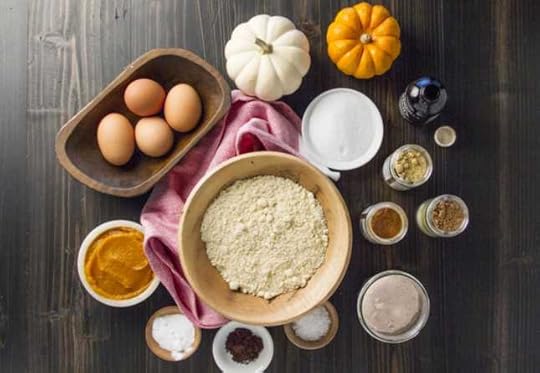
1 ½ cups blanched almond flour
½ teaspoon fine sea salt
¾ teaspoon aluminum-free baking soda
2 ½ teaspoons ground cinnamon
½ teaspoon ground cloves
¼ teaspoon ground nutmeg
¼ teaspoon ground ginger
4 large eggs
¾ cup organic pumpkin puree (not pumpkin pie filling)
¼ cup Swerve
1 teaspoon vanilla extract
*½ cup of optional mix-ins: chopped pecans or walnuts
Instructions:
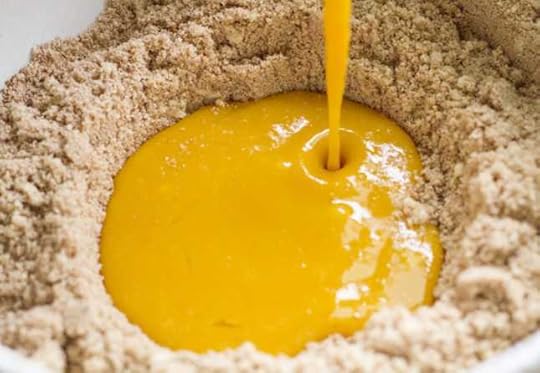
Preheat oven to 350ºF. Place rack in center of the oven.
Grease an 8×4-inch loaf pan with butter or coconut oil and line with parchment paper so the paper overlaps the sides like handles. Grease the parchment paper lightly.
Sift almond flour to break up lumps.
In a large bowl, stir together almond flour, salt, baking soda, and spices. In a separate bowl, whisk together the eggs, pumpkin, Swerve, and vanilla extract. Make a well in the center of the dry ingredients, and pour in the wet. Gently stir until batter is just combined. Fold in any mix-ins.
Scrape into prepared loaf pan, and smooth the top of the batter. Bake for 43–46 minutes, or until a toothpick inserted in the center of the loaf comes out clean. Remove from oven and set aside to cool (for about 30 minutes). Lift the bread out using the parchment handles, peel off the paper, and slice.
Store leftovers in an airtight container for 5 days in the refrigerator. To freeze, wrap bread tightly (aluminum foil works) and store in freezer for 3 months.
Nutritional Information (per serving):
Calories: 137
Fat: 10.7 grams
Protein: 6.2 grams
Net Carbs: 7.7 grams


The post Low-Carb Pumpkin Bread appeared first on Mark's Daily Apple.



Mark Sisson's Blog
- Mark Sisson's profile
- 199 followers



